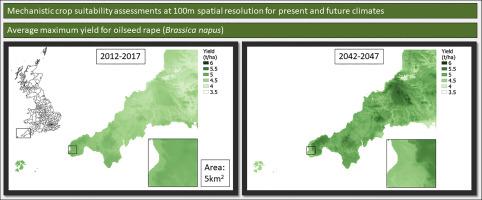Agricultural Systems ( IF 6.1 ) Pub Date : 2021-02-02 , DOI: 10.1016/j.agsy.2021.103084 A.S. Gardner , I.M.D. Maclean , K.J. Gaston , L. Bütikofer

|
Context
Against a background of unprecedented climate change, humanity faces the challenge of how to increase global food production without compromising the natural environment. Crop suitability models can indicate the best locations to grow different crops and, in doing so, support efficient use of land to leave space for, or share space with, nature. However, challenges in downscaling the climate data needed to drive these models to make predictions for the future has meant that they are often run using national or regional climate projections. At finer spatial scales, variation in climate conditions can have a substantial influence on yield and so the continued use of coarse resolution climate data risks maladaptive agricultural decisions. Opportunities to grow novel crops, for which knowledge of local variation in microclimate may be critical, may be missed.
Objective
We demonstrate how microclimate information can be acquired for a region and used to run a mechanistic crop suitability model under present day and possible future climate scenarios.
Methods
We use microclimate modelling techniques to generate 100 m spatial resolution climate datasets for the south-west of the UK for present day (2012–2017) and predicted future (2042–2047) time periods. We use these data to run the mechanistic crop model WOrld FOod STudies (WOFOST) for 56 crop varieties, which returns information on maximum crop yields for each planting month.
Results and conclusions
Over short distances, we find that the highest attainable yields vary substantially and discuss how these differences mean that field-level assessments of climate suitability could support land-use decisions, enabling food production whilst protecting biodiversity.
Significance
We provide code for running WOFOST in the WofostR R package, thus enabling integration with microclimate models and meaning that our methodology could be applied anywhere in the world. As such, we make available to anyone the tools to predict climate suitability for crops at high spatial resolution for both present day and possible future climate scenarios.
中文翻译:

利用小气候数据预测未来作物的适宜性
语境
在前所未有的气候变化背景下,人类面临着如何在不损害自然环境的前提下增加全球粮食产量的挑战。作物适宜性模型可以指示出种植不同作物的最佳地点,并以此来支持有效利用土地为自然留出空间或与自然共享空间。但是,降低驱动这些模型做出未来预测所需的气候数据规模面临挑战,这意味着它们经常使用国家或地区气候预测来运行。在更精细的空间尺度上,气候条件的变化会对产量产生重大影响,因此继续使用粗略分辨率的气候数据可能会导致农业决策失误。种植新作物的机会,对于这些作物而言,了解小气候的局部变化可能至关重要,
目的
我们演示了如何在一个地区以及当前和未来可能的气候情景下,获取一个地区的微气候信息,并用于运行一个机械作物适应性模型。
方法
我们使用微气候建模技术来生成英国西南部当前(2012–2017)和预测未来(2042–2047)时间段的100 m空间分辨率气候数据集。我们使用这些数据对56个作物品种运行机械作物模型WOrld FOOD STUDIES(WOFOST),该模型返回每个播种月份的最大作物产量信息。
结果与结论
在短距离内,我们发现可达到的最高产量有很大不同,并讨论了这些差异如何意味着对气候适宜性的现场评估可以支持土地使用决策,从而在保护生物多样性的同时实现粮食生产。
意义
我们在WofostR R软件包中提供了用于运行WOFOST的代码,从而实现了与微气候模型的集成,这意味着我们的方法可以在世界任何地方应用。因此,我们为所有人提供了用于预测当今和未来气候情景的高空间分辨率作物气候适应性的工具。











































 京公网安备 11010802027423号
京公网安备 11010802027423号